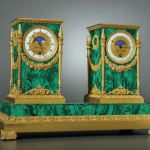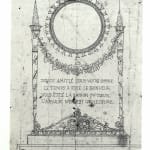
Hans Ottomeyer and Peter Pröschel, “Vergoldete Bronzen”, 1986, p 318, pl. 5 b, illustrating a design for a single clock case by Charles Percier of circa 1800, now in the Musée des Beaux-Arts at Rennes, which is identical to each of the present clock plinths.
Lesieur
Literature
Hans Ottomeyer and Peter Pröschel, “Vergoldete Bronzen”, 1986, p 318, pl. 5 b, illustrating a design for a single clock case by Charles Percier of circa 1800, now in the Musée des Beaux-Arts at Rennes, which is identical to each of the present clock plinths.
Caroline Clifton-Mogg, "The Neoclassical Source Book", 1991, illustrating this clock.
A superb Empire astronomical gilt bronze mounted malachite clock, signed on the ornate enamel dials LESIEUR A PARIS ANNEE 1819. The movement housed in the left hand clock plinth with anchor escapement and silk thread suspension, connected by a fine chain via the base to the movement in the right hand plinth to a power supply that activates the striking mechanism and in turn the calendar work. Each clock surmounted by a detachable gadrooned tazza with serpentine handles and housed in very fine rectangular plinth-shaped case after a design by Charles Percier, which is mounted on the four corners with flaming torches, with oak leaf swags below the superb anthemion cast dial bezel and an elaborate scrolled acanthus and rosette mount above the stepped base with acanthus border, the sides similarly decorated but with wreaths in place of the dial, the clock and calendar plinths placed side by side and set on a stepped rectangular gilt bronze base with a gilt bronze stiff leaf border on foliate lion paw feet with cases ornamented on each side with wreaths, swags and flaming torcheres, after a design by Charles Percier (1764-1838)
Paris, dated 1819
Height 24.5 cm, length 35 cm, depth 17 cm.
This type of dual bureau clock and calendar, appears to be a speciality of the Parisian clockmaker Lesieur (fl. 1790-1850). His name appears on the dial of several identical examples including one from 1819, with the plinths and base encased in malachite, which was sold by this gallery (illustrated in “Richard Redding Masterpieces of the Past”, 1996, p. 5). The design for each of the plinth-shaped cases is from a pen and ink design by Charles Percier (1764-1838) for a single but almost identical clock case (now in the Musée des Beaux-Arts at Rennes); it features the same flaming torches, oak leaf swags below the dial and scrolling mount at the foot of the plinth but has the added inscription below the dial: Douce amité sous votree Empire/Le Temps à fixé de Bonheur/Vous êtes la raison du coeur/L’amour n’en est que le delire.
Charles Percier together with his friend and collaborator, Pierre Fontaine (1762-1853), were Napoleon’s chief architects and ornementalistes and were the main inspiration behind the creation of the Empire style. After they had transformed Joséphine’s apartments at Malmaison, Napoleon employed them to create a complete artistic style in keeping with his role as Emperor. Percier and Fontaine designed everything from buildings and interior decorations to furniture, silver and clocks. After the fall of Napoleon, they continued to enjoy official patronage but tended to work independently of one another.
Lesieur was a highly respected but little documented clockmaker who was working in Paris during the last years of the eighteenth century and continued in business up until circa 1850. Tardy notes that by 1806 he was established at Vieille rue du Temple; during 1812-20 and 1830-50 he was at rue de la Verrerie and in 1840 at Boulevard St. Martin. Elsewhere in the Paris almanacs he is recorded at Bar-du-Bec in 1839 and in 1840 at rue des Alexiens. In addition to the present example Lesieur and G. Mayer provided the movements for an interesting pair of figural clocks featuring female and male classical warriors seated upon a canon, in which one with dial signed Lesieur à Paris, indicates the calendar indications and the other, which is signed G. Mayer à Chalon-sur-Saône, indicates the hours and minutes (illustrated in Pierre Kjellberg, “La Pendule Française du Moyen Age au XXe Siècle”, 1997, p. 410, pl. E).


